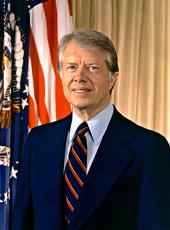
Highway Safety and National Traffic and Motor Vehicle Safety Acts of 1966 Message to the Congress Transmitting Two Reports.
To the Congress of the United States:
The Highway Safety Act and the National Traffic and Motor Vehicle Safety Act, both enacted in 1966, initiated a cohesive national effort to reduce the deaths and injuries on the Nation's highways and require annual reports on the administration of these acts.
The report on motor vehicle safety includes the annual report required by Title I of the Motor Vehicle Information and Cost Savings Act of 1972 (bumper standards). An annual report is also required by the Energy Policy and Conservation Act of 1975 which amended the Motor Vehicle Information and Cost Savings Act and directed the Secretary of Transportation to set, adjust and enforce motor vehicle fuel economy standards. Similar reporting requirements are contained in the Department of Energy Act of 1978 with respect to the use of advanced technology by the automobile industry. These requirements have been met in the Fourth Annual Fuel Economy Report, the highlights of which are summarized in the motor vehicle safety report.
In the Highway Safety Acts of 1973, 1976 and 1978, the Congress expressed its special interest in certain aspects of traffic safety which are addressed in the volume on highway safety.
The combination of motor vehicle and highway safety standards, enforcement, and research have reduced the fatality rate by about 39 percent. This reduction has been achieved in spite of tremendous increases in traffic volume—registered motor vehicles up 67 percent, licensed drivers up 42 percent, vehicle miles driven up 64 percent.
Even so, 51,083 people met violent deaths on the highways in 1979—up from 50,331 in 1978. Based on current trends, each person born this year can expect to be involved in a crash every 10 years. One in 60 will be killed, and one in 20 will be seriously injured.
In addition to the persistent problems of drunk driving and speeding, several influences have contributed to the upward trend in fatalities: the increasing nonobservance of the 55 mph speed limit, which in some States is only lightly enforced; the repeal, or weakening, of motorcycle helmet laws; the increasingly widespread use of vans and light trucks, which have not been subject to the majority of Federal motor vehicle safety standards; the fact that the Nation's roads are deteriorating faster than they can be maintained, especially the non-Interstate Systems, where more than 90 percent of all fatal accidents occur; and the shift to smaller, lighter cars.
While small cars made up only 38 percent of the cars on the road in 1979, small car occupants accounted for a disproportionate 55 percent of the deaths that year in two-vehicle crashes. Because of the lower weight of smaller cars, their occupants fare poorly in collisions, particularly in collisions with heavier vehicles. In a crash between a subcompact car and a full-sized model which is severe enough to cause a fatality, the occupants of the small car are eight times more likely to be killed than the occupants of the large car.
As America moves into the small car era, the consequences of ignoring the need for further safety improvements become unacceptable in both human and economic terms. Traffic safety must be given a high priority by Federal, State and municipal Governments, by the automotive industry, by private organizations, and most important of all, by the potential victims of highway accidents—the public.
JIMMY CARTER
The White House,
January 13, 1981.
Note: The reports are entitled "Traffic Safety '79: A Report on Activities Under the Highway Safety Act of 1966 as Amended, January 1, 1979-December 31, 1979—U.S. Department of Transportation, National Highway Traffic Safety Administration, Federal Highway Administration" and "Traffic Safety '79: A Report on Activities Under the National Traffic and Motor Vehicle Safety Act of 1966 as Amended and the Motor Vehicle Information and Cost Savings Act of 1972 as Amended and the Energy Policy and Conservation Act of 1975, January 1, 1979-December 31, 1979-U.S. Department of Transportation, National Highway Traffic Safety Administration" (Government Printing Office).
Jimmy Carter, Highway Safety and National Traffic and Motor Vehicle Safety Acts of 1966 Message to the Congress Transmitting Two Reports. Online by Gerhard Peters and John T. Woolley, The American Presidency Project https://www.presidency.ucsb.edu/node/250620
